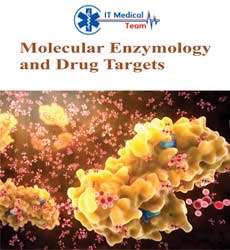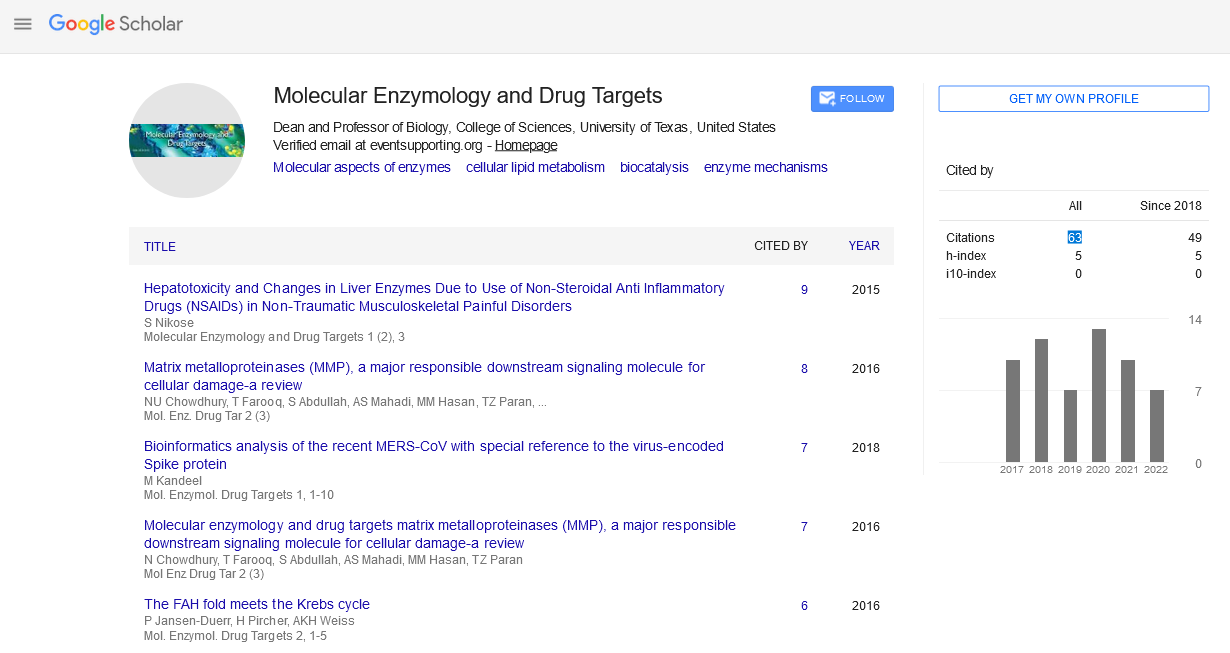Keywords
|
| Francisella tularensis; Phagocyte; Enzyme |
Introduction
|
| The genus of Francisella involves Gram negative, non-motile, and facultative intracellular pathogenic bacteria. It may cause different types of zoonotic infection of tularemia including glandular, oculoglandular, ulceroglandular, oropharyngeal (gastrointestinal), respiratory (pneumonic), and typhoidal demonstrations [1-4]. |
| Francisella genus includes two species of Francisella tularensis (F. tularensis) and F.philomiragia. Besides, F. tularensis involves four subspecies (spp.) of tularensis (type A), novicida, holarctica (type B) and mediasiatica. However, the classification of F. tularensis ssp. novicida and F.novicida is variable in different sources [2-6]. |
| Transmission of tularemia is achieved via direct contact with insect vectors, infected animals, ingesting contaminated food or water, and inhalation of aerosolized bacteria [7-10]. |
| The harshness of tularemia is directly associated with the bacterial cell number, the way of bacterial entrance, and the bacterial species and subspecies. The most severe form of tularemia is caused by F. tularensis subspecies (spp.) tularensis. With ignorance of bacterial entrance, the lethal dosage of F. tularensis ssp. tularensis is about 10 cells and the rate of mortality in untreated situation is up to 35%. Thus, this subspecies is recognized as an important case regarding to bioterrorism concern. The centers for infectious diseases control and prevention (CDC) have classified the life threatening bacterium of F. tularensis spp. tularensis in category A [2,3,6,9,11,12]. |
| In accordance with previous studies, the intracellular life cycle of Francisella within a host cell begins by entrance into the phagocytes and continues via bioactivities and replication. The host cells consist of alveolar and dendritic cells, fibroblasts, hepatocytes, macrophages and polymorphonuclear leukocytes (neutrophils) [2,13-16]. |
| The process of intracellular replication is known as an important factor regarding to F. tularensis pathogenicity. The formation of pseudopod loops in macrophages reveals the entrance of F. tularensis into the cell. The bacterial entrance is followed by phagosomal creation within the host cell. The maturation of phagosomes containing bacterial cells of F. tularensis may lead to bacterial degradation. This mechanism is observed for other intracellular pathogenic bacteria like Legionella pneumophila, Mycobacterium tuberculosis, Salmonella typhimurium, Coxiella, Shigella flexneri, Listeria monocytogenes, Bartonella spp., Chlamydia spp., Rickettsia spp., and Brucella spp. The proton ATPase pump enables maturated phagolysosome to have a successfully achieve bacterial degradation throughout the process of acidification. For preventing degradation and hydrolyzation of the trapped bacteria, each bacterial genus has its special defense system. Normally, the intracellular bacteria are equipped by type III secretion system or type IV to escape from bacterial degradation; but F. tularensis is excluded. Regarding to F. tularensis, several factors such as Francisella Pathogenicity Island (FPI) regulates phagosomal escape, ensures bacterial survival and supports bacterial proliferation [4,8,17-28]. |
| In this review, the commonest enzymatic pathways relating to bacterial intracellular survival, replication and phagosomal escape in F. tularensis are discussed. |
|
Francisella pathogenicity island and bacterial intracellular life cycle
|
| The 30-33 Kb FPI consists of several important virulent genes (up to 19 genes) including iglA-D (responsible for intracellular growth of Francisella within macrophages), iglG (virulence factor), iglI and pdpA-E which are in association with bacterial intracellular activities and replication [8,18,19,27,29-34]. |
| During the process of phagocytosis, Francisella bacterial cells are uptaken into the macrophages and kept within phagosomes. The outcome of phagosomal maturation is the appearance of a bactericidal structure of phagolysosome. While, several studies show that, prior to phagosomal maturation, Francisella bacterial cells break down phagosomal membrane via isoenzymes of acid phosphatase. The process of membrane disruption usually occurs up to 1 hour after phagocytosis and may lead to release of bacteria into the macrophage cytosol and is followed by bacterial replication. The processes of apoptosis or autophagy are seen as postinfectional phase in macrophages [5-42]. |
| Moreover, FPI encodes type VI secretion system which contributes to bacterial escape from phagosomal space into the macrophage cytosol milieu [8,43,44]. |
| Another survey shows that, the escaping stage within Francisella containing phagosome (FCP) occurs via the proton vacuolar ATPase pump (vATPase pump). This pump is actually in association with degradation of trapped bacteria within the space of phagosomes. But, the evolution of Francisella bacteria has provided them a suitable means for escaping from phagosome into the macrophage's cytosol. As mentioned above, the secretion system type VI is the evolved mechanism which disrupts the phagosomal membrane in parallel with vATPase proton pump activity. This process is followed by bacterial replication within the macrophage cytoplasm. Recent studies show that, the secretion system type VI inhibits the activity of vATPase proton pump. In another word, activation of secretion system type VI deactivates the role of vATPase proton pump and may lead to bacterial phagosomal escape [37,45-48]. |
| The process of bacterial escaping relating to Francisella in neutrophils differs from macrophages. The bacteria prevent assembly of phagocytes' nicotinamide adenine dinucleotide phosphate (NADPH) oxidase and inactivation of NADPH oxidase leads to bacterial intracellular survival [3,14,49,50]. |
| New studies indicate that the process of acidification of Francisella Containing Phagosomes (FCPs) within neutrophil milieu is in parallel with NADPH oxidase activity. The active membranal NADPH oxidase (in phagocytes) is able to convert molecular oxygen into reactive oxygen species (ROS) and other types of superoxide anions such as hypochlorous acid, hydrogen peroxide and peroxynitrite. The ROS protect phagocytes' intracellular milieu from outsiders. On the other hand, Francisella bacteria encompass a wide range of enzymes including acid phosphatase, superoxide dismutase, and catalase KatG (in some subspecies) are multifunctional tools that provide appropriate situations for bacterial intracellular survival, phagosomal escape and multiplication [4,42,51-57]. |
Acid phosphatase
|
| Acid phosphatase enzymes are able to break down different substrates such as peptides and proteins which encompass phosphorylated amino acid of tyrosine, phosphorylated inositol, phospholipid, AMP, ATP, NADP and etc. [39,58]. |
| Acid phosphatases are recognized as bacterial virulence factors in association with F. tularensis. F. tularensis possesses a number of genes including acpA-C and hap that are responsible for acid phosphatase enzymes. The acid phosphatase enzymes include AcpA-C and Hap is responsible for preventing NADPH oxidase assembly. Besides, the aforementioned enzymes are needed for bacterial intracellular survival and phagosomal escape. Acid phosphatases are able to prevent the respiratory burst within phagocytes like neutrophils [39,49,51,53]. |
Superoxide dismutase (SOD)
|
| Superoxide dismutase enzymes catalyze produced superoxide anions into molecular oxygen and hydrogen peroxide throughout the process of dismutation in the presence of their metal cofactors including Mn-, Fe-, and CuZn. sodB and sodC genes are present in Francisella spp. which encode SODs. SODs are needed for pathogenesis and bacterial intracellular survival via detoxifying of ROS produced within phagocytes. The enzyme of catalase KatG, is responsible for H2O2 conversion into oxygen and water in mice [49,50,55]. |
NADPH oxidase
|
| An assembled and activated NADPH oxidase is ready for destroying microbial agents. The enzyme is sensitive and it would be activated right after any induction. Recent investigations show that, NADPH oxidase is an electrogenic enzyme, which sends the produced electrons into the phagosomes. This enzyme is a component of a phagocytic cell that mediates the interaction of NADPH and molecular oxygen to produce ROS. This system is advanced defense machinery which is recognized within eosinophils, macrophages, monocytes, neutrophils. The superoxide anions may be converted into hydrogen peroxide by the catalytic activity of superoxide dismutase [49,59-63]. |
| The NADPH oxidase enzyme is structurally composed of two membranous subunits of gp91PHOX (PHOX: Phagocyte Oxidase) and p22PHOX, three cytosolic soluble compartments of gp67PHOX, p40PHOX, p47PHOX and G protein [62,63]. |
| The p22PHOX and gp91PHOX (flavocytochrome b558) are situated within the membrane. The gp91PHOX is the main core of NADPH oxidase and encompasses a cytosolic tail. The complex is able to attach to free cytosolic phosphorylated p47PHOX and other components like p40PHOX and G protein to provide an activated oxidase. The p47PHOX takes soluble cytosolic proteins into the membraneous proteins. The p47PHOX contributes to produce superoxide, but in the presence of high amount of gp67PHOX, there is no need for p47PHOX, except in neutrophils. gp67PHOX is an important part of NADPH oxidase that mediates superoxide formation throughout transmission of electrons from NADPH part to molecular oxygen [62-68]. |
| Francisella bacteria are able to survive within phagocytes via blocking either the attachment of cytosolic soluble components of NADPH oxidase into the enzymatic proteins of phagosomal membranes or the process of phosphorylation p47PHOX and p40PHOX Indeed, the regulated activity of flavocytochrome is targeted by the Francisella [2,6,63]. |
Conclusion
|
| Francisella tularensis is responsible for severe forms of tularemia. The Francisella enzymatic machinery is an essential defense system which guarantees the bacterial growth, survival, replication and phagosomal escaping process. Moreover, the host cells are protected with enzymatic machinery which supports them against foreigners including microbial infectious agents. Recognition of enzymatic systems belonging to host cells and bacterial pathogens may lead to provide more effective and appropriate antibiotics for a definite treatment. |





